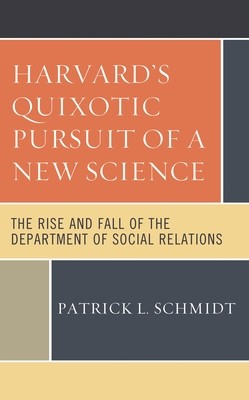
- We will send in 10–14 business days.
- Author: Patrick L Schmidt
- Publisher: Rowman & Littlefield Publishers
- Year: 2022
- ISBN-10: 1538168286
- ISBN-13: 9781538168288
- Format: 15.2 x 22.9 x 1.9 cm, hardcover
- Language: English
- SAVE -10% with code: EXTRA
Reviews
Description
In Harvard's Quixotic Pursuit of a New Science, Patrick L. Schmidt tells the little-known story of how some of the most renowned social scientists of the twentieth century struggled to elevate their emerging disciplines of cultural anthropology, sociology, and social and clinical psychology. Scorned and marginalized in their respective departments in the 1930s for pursuing the controversial theories of Freud and Jung, they persuaded Harvard to establish a new department, promising to create an interdisciplinary science that would surpass in importance Harvard's "big three" disciplines of economics, government, and history. Although the Department of Social Relations failed to achieve this audacious goal, it nonetheless attracted an outstanding faculty, produced important scholarly work, and trained many notable graduates. At times, it was a wild ride. Some faculty became notorious for their questionable research: Timothy Leary and Richard Alpert (reborn as Ram Dass) gave the psychedelic drug psilocybin to students, while Henry Murray traumatized undergraduate Theodore Kaczynski (later the Unabomber) in a three-year-long experiment. Central to the story is the obsessive quest of legendary sociologist Talcott Parsons for a single theory unifying the social sciences- the white whale to his Captain Ahab. All in all, Schmidt's lively narrative is an instructive tale of academic infighting, hubris, and scandal.
EXTRA 10 % discount with code: EXTRA
The promotion ends in 16d.12:46:47
The discount code is valid when purchasing from 10 €. Discounts do not stack.
- Author: Patrick L Schmidt
- Publisher: Rowman & Littlefield Publishers
- Year: 2022
- ISBN-10: 1538168286
- ISBN-13: 9781538168288
- Format: 15.2 x 22.9 x 1.9 cm, hardcover
- Language: English English
In Harvard's Quixotic Pursuit of a New Science, Patrick L. Schmidt tells the little-known story of how some of the most renowned social scientists of the twentieth century struggled to elevate their emerging disciplines of cultural anthropology, sociology, and social and clinical psychology. Scorned and marginalized in their respective departments in the 1930s for pursuing the controversial theories of Freud and Jung, they persuaded Harvard to establish a new department, promising to create an interdisciplinary science that would surpass in importance Harvard's "big three" disciplines of economics, government, and history. Although the Department of Social Relations failed to achieve this audacious goal, it nonetheless attracted an outstanding faculty, produced important scholarly work, and trained many notable graduates. At times, it was a wild ride. Some faculty became notorious for their questionable research: Timothy Leary and Richard Alpert (reborn as Ram Dass) gave the psychedelic drug psilocybin to students, while Henry Murray traumatized undergraduate Theodore Kaczynski (later the Unabomber) in a three-year-long experiment. Central to the story is the obsessive quest of legendary sociologist Talcott Parsons for a single theory unifying the social sciences- the white whale to his Captain Ahab. All in all, Schmidt's lively narrative is an instructive tale of academic infighting, hubris, and scandal.


Reviews